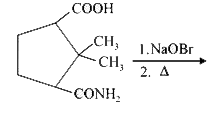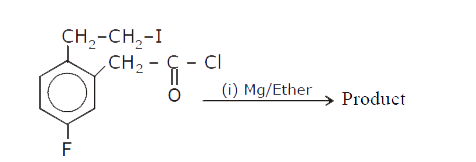Final product formed on reaction of glycerol by HI acid is :
Propane
Propanoic acid
iso-propyl iodide
Propyne
The correct Answer is:C
To determine the final product formed when glycerol reacts with hydrogen iodide (HI), we can follow these steps:
1. Identify the Structure of Glycerol:
Glycerol (C3H8O3) has the following structure:
CH2OH−CHOH−CH2OH
It contains three hydroxyl (–OH) groups.
2. Reaction with Hydrogen Iodide (HI):
When glycerol reacts with HI, each hydroxyl group can react with HI, leading to the substitution of the –OH group with iodine (I).
3. Mechanism of Reaction:
- The electronegative iodine pulls electrons from the hydrogen, creating a positive charge on hydrogen.
- The hydroxyl group (–OH) is protonated to form water (H2O), which is a good leaving group.
- The iodide ion (I⁻) then attacks the carbon atom where the –OH group was, leading to the formation of iodo derivatives.
4. Formation of Iodine Substituted Glycerol:
After the reaction of glycerol with three moles of HI, we would initially get:
CH2I−CHOH−CH2I
However, this intermediate is unstable due to steric hindrance from the bulky iodine atoms.
5. Elimination of Iodine:
The instability leads to the elimination of two iodine molecules (I2) from the structure, resulting in the formation of a double bond:
CH2I−C=CH−CH2I
6. Final Product Formation:
The reaction continues with the addition of HI, leading to the formation of isopropyl iodide (C3H7I):
CH3−CH(I)−CH3
This compound is known as isopropyl iodide.
Final Answer:
The final product formed on the reaction of glycerol with hydrogen iodide is isopropyl iodide.
---
Glycerol (C3H8O3) has the following structure:
CH2OH−CHOH−CH2OH
It contains three hydroxyl (–OH) groups.
When glycerol reacts with HI, each hydroxyl group can react with HI, leading to the substitution of the –OH group with iodine (I).
- The electronegative iodine pulls electrons from the hydrogen, creating a positive charge on hydrogen.
- The hydroxyl group (–OH) is protonated to form water (H2O), which is a good leaving group.
- The iodide ion (I⁻) then attacks the carbon atom where the –OH group was, leading to the formation of iodo derivatives.
After the reaction of glycerol with three moles of HI, we would initially get:
CH2I−CHOH−CH2I
However, this intermediate is unstable due to steric hindrance from the bulky iodine atoms.
The instability leads to the elimination of two iodine molecules (I2) from the structure, resulting in the formation of a double bond:
CH2I−C=CH−CH2I
The reaction continues with the addition of HI, leading to the formation of isopropyl iodide (C3H7I):
CH3−CH(I)−CH3
This compound is known as isopropyl iodide.
The final product formed on the reaction of glycerol with hydrogen iodide is isopropyl iodide.
Similar Questions
Knowledge Check
- Question 1 - Select One
Final product formed on reduction of glycerol by hydriodic acid is
APropaneBPropanoic acidCPropaneDNone of these - Question 2 - Select One
Final product formed on reduction of glycerol by periodic acid is
ApropaneBpropanoic acidCpropeneDnone of these. - Question 3 - Select One
Final product formed on reduction of glycerol by huydroiodic acid is
APropaneBPropanoic acidCpropeneDpropyne








